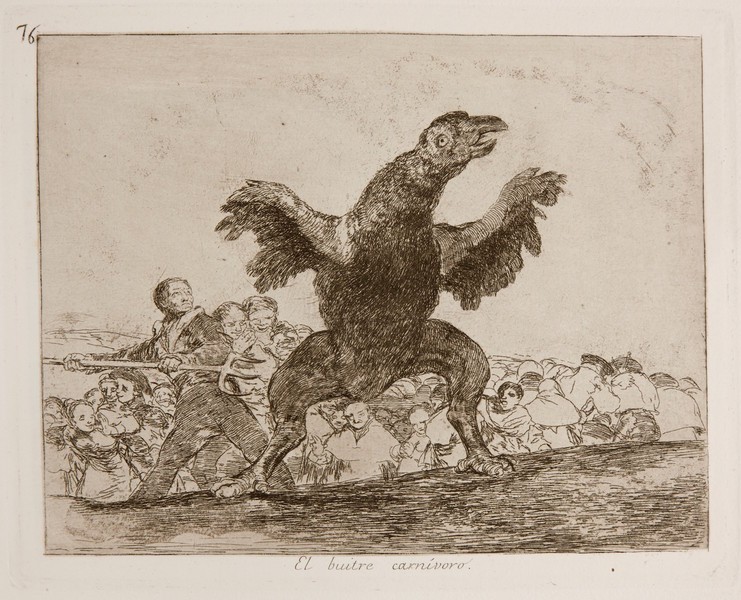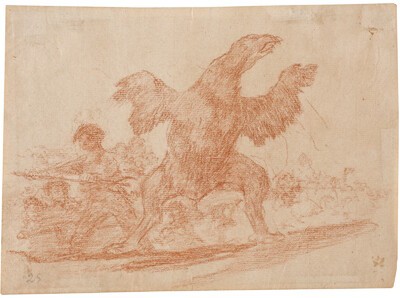- Cronología
- Ca. 1820 - 1823
- Dimensiones
- 177 x 221 mm
- Técnica y soporte
- Etching, burin, drypoint and burnisher
- Reconocimiento de la autoría de Goya
- Undisputed work
- Ficha: realización/revisión
- 04 Jan 2011 / 02 Jun 2023
- Inventario
- 225
76 (in the top left-hand corner).
See Sad forebodings of what is to come.
In the third state test with drypoint and/or burin, some parts of the vulture have been shaded and reinforced. The outline of the gallows and the man's left hip and thigh have been reinforced with the burin line, with traces of the generalised false bite producing an aquatint effect on the ground. The figures and the sky are burnished.The title of the print was handwritten by Goya on the first and only series known to us at the time of its production, which the painter gave to his friend Agustín Ceán Bermúdez. Thus the title was subsequently engraved on the plate without any modification from Ceán Bermúdez's copy for the first edition of the Disasters of War published by the Royal Academy of Fine Arts of San Fernando in Madrid in 1863.
A preparatory drawing of this engraving is in the Prado Museum
In the centre of the composition a giant bird, a vulture as the title of the engraving states, runs in terror with its wings outstretched. Behind him a peasant threatens him with a pitchfork and further back we see a large crowd watching the scene.
This image is linked by its formal treatment with the previous one, No. 75, Charlatans' Parade and the following one, No. 77, The Rope Breaks. In all three, the compositional axis is a large figure extending its upper limbs.
As with the rest of the Emphatic Caprices, this engraving is very difficult to interpret. In some cases it has been thought that the vulture could be an allusion to the French army that was expelled from Spain by the people and, therefore, a reference to the end of the war. The animal is somewhat battered, with no tail or feathers, perhaps as a result of the harshness of the confrontation. The figures in the background who are fleeing in terror could be French soldiers who deserted.
Nigel Glendinning relates this engraving to a poem by Juan Bautista de Arriaza (Madrid, 1770-Madrid, 1837), Prophecy of the Pyrenees (1808), which was widely circulated during the War of Independence on account of its patriotic content. The Englishman was able to perceive certain analogies between the engraving of The Carnivorous Vulture and the stanzas of the Prophecy of the Pyrenees in which the following is said: "And flee among your warriors, / Like a band of butcher vultures". The English historian also believes that Goya may have been inspired by the work Gli animali parlanti (1801) by Giambattista Casti (Viterbo or Acquapendente, 1724-Paris, 1803).
One of the visual sources to which the Aragonese painter may have had recourse for this print is the engraving by Stefano della Bella (Florence, 1610-Florence, 1664) The Ostrich Hunt (ca.1650, Library degli Intronati, Siena) in which the animal with its wings spread out appears in the foreground. Della Bella closely captures the anguish of the animal about to be captured in a hunting scene, in which, until then, this aspect was completely irrelevant.
The plate is in the National Chalcography (cat. 327).
-
De grafiek van GoyaRijksmuseum RijksprentenkabinetAmsterdam1970from November 13th 1970 to January 17th 1971cat. 87
-
Goya. Das Zeitalter der Revolucionen. Kunst um 1800 (1980 – 1981)Hamburger KunsthalleHamburg1980cat. 61
-
Francisco de GoyaMuseo d'Arte ModernaLugano1996exhibition celebrated from September 22nd to November 17th.cat. 76
-
Francisco Goya. Sein leben im spiegel der graphik. Fuendetodos 1746-1828 Bordeaux. 1746-1996Galerie KornfeldBern1996from November 21st 1996 to January 1997cat. 166
-
Ydioma universal: Goya en la Biblioteca NacionalBiblioteca NacionalMadrid1996from September 19th to December 15th 1996cat. 230
-
Francisco Goya. Capricci, follie e disastri della guerraSan Donato Milanese2000Opere grafiche della Fondazione Antonio Mazzottacat. 156
-
Goya: Prophet der ModerneAlte NationalgalerieBerlin2005from July 13th to October 3th 2005. Exhibitied also at the Kunsthistorischemuseum, Vienna, October 18th 2005 to January 8th 2006, consultant editor Manuela B. Mena Marquéscat. 124
-
Goya et la modernitéPinacothèque de ParisParís2013from October 11st 2013 to March 16th 2014cat. 115
-
Goya, grabadorMadridBlass S.A.1918cat. 178
-
Goya engravings and lithographs, vol. I y II.OxfordBruno Cassirer1964cat. 196
-
Vie et ouvre de Francisco de GoyaParísOffice du livre1970cat. 1126
-
A solution to the enigma of Goya’s emphatic caprices nº 65-80 of The Disasters of WarApollo1978pp.186-191
-
Catálogo de las estampas de Goya en la Biblioteca NacionalMadridMinisterio de Educación y Cultura, Biblioteca Nacional1996cat. 299
-
ParísPinacoteca de París2013p. 157
-
Goya. In the Norton Simon MuseumPasadenaNorton Simon Museum2016pp. 114-151

